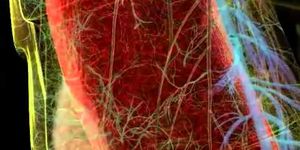In a version of the classic Prisoner's Dilemma game, two monkeys are each given the opportunity to choose one of two symbols - the circle indicating cooperation with the other animal and the triangle indicting defection. How much juice each monkey receives depends on the choices of both animals; so each monkey must predict what the other will choose in order to maximize the juice reward.

A new MGH study has identified a group of neurons activated in brains of these monkeys when they predict the as-yet unknown intentions of the other animals. Every day we make decisions based on predicting what someone else will do - from deciding whether the driver approaching an intersection will stop for the red light to determining whether a particular negotiation strategy will result in a desired outcome.
Now a study by Massachusetts General Hospital (MGH) investigators has discovered two groups of neurons that play key roles in social interactions between primates - one that is activated when deciding whether to cooperate with another individual and another group involved in predicting what the other will do. Their findings appear in the March 12 issue of Cell and have been published online.
"For a long time we have been interested in understanding how complex social interactions between individuals are mediated by neurons within the brain," said Keren Haroush, PhD, of MGH Department of Neurosurgery and the MGH-HMS Center for Nervous Systems Repair, lead author of the Cell paper. "We found that part of the frontal lobe called the anterior cingulate cortex plays an essential role in mediating cooperative social interactions in Rhesus monkeys. Some neurons encode the animal's decision whether or not to cooperate with another monkey, and a separate group was activated in predicting what the other monkey would do before it had made its selection. The activity of those other-predictive neurons was uniquely affected by the social context of the interaction."
The anterior cingulate cortex (ACC) is broadly connected with other brain regions known to be involved in interactive behavior, and damage to the ACC results in reduced interest in other individuals compared with inanimate objects. In fact, people with autism spectrum disorders or other conditions affecting social interactions, such as antisocial personality disorder, have been found to have abnormalities in the ACC.
To better understand the role of the ACC in making one's own decisions and predicting what another individual will do, Haroush and senior author Ziv Williams, MD, also of MGH Neurosurgery and the MGH-HMS Center for Nervous Systems Repair, tested pairs of monkeys in a version of the classic Prisoner's Dilemma game. In the game, each monkey is given a choice - in this instance which of two displayed symbols to choose - and the relationship between the two animals' choices determines how much of a reward each will receive.
In repeated trials with the monkeys sitting next to each other, the animals learn through experience that one symbol represents cooperation with the other monkey and the other represents a lack of cooperation called defection. If both animals choose the cooperation symbol, both get an equally large drink of juice, but if one chooses defection and the other chooses cooperation, the defector gets the largest amount of juice and the cooperator gets the smallest. However, if both animals choose to defect, both get an equally small drink of juice; so deciding how to get more juice involves predicting what the other animal will choose.
Each trial randomly alternated which animal was given the opportunity to choose first. After both had made their choices, the monkeys could see what each had chosen and detect how much juice each received. While the animals were more likely to select defection versus cooperation overall, they were less likely to cooperate if the other monkey had defected on the previous trial. Mutual cooperation between both monkeys increased the likelihood of cooperation on future trials. Two versions of the trial that changed the social context of the experiment - one in which the monkeys were in separate rooms and the other in which a monkey played against a computer - significantly reduced the likelihood of cooperation and of reciprocation after previous mutual cooperation.
Measuring the activity of 353 individual neurons within the ACC while the monkeys performed the trials revealed that about half were activated during the task. Of these task-responsive neurons, a quarter showed differences in activation based on the animals' individual choice, and an even larger group - a third of those involved in the task - showed changes in activation corresponding with the as-yet unknown choice of the other monkeys. The predictions made by the activity of these neurons were as accurate as those made by an algorithm that evaluated the animals' previous choices.
Williams notes, "We also found that these ‘other-predictive' neurons were uniquely affected by the social context of the interaction and were much less active when the animals were separated, supporting the role of these neurons in anticipating another individual's intentions or covert state of mind. In addition, temporarily disrupting the activity of the ACC during a series of trials reduced the overall likelihood of cooperation and specifically of reciprocal cooperation, which is in line with previous studies that have found ACC involvement in disorders affecting social interaction.
"Social interactions are complex, and here we touched on only a small aspect of how individuals interact," he adds. Our eventual hope is to better understand how these complex, multifaceted interactions are encoded within the human brain and use this understanding to develop new, targeted treatment for disorders such as autism and antisocial behavior, which are often characterized by difficulty with social interaction."
Source: Massachusetts General Hospital









